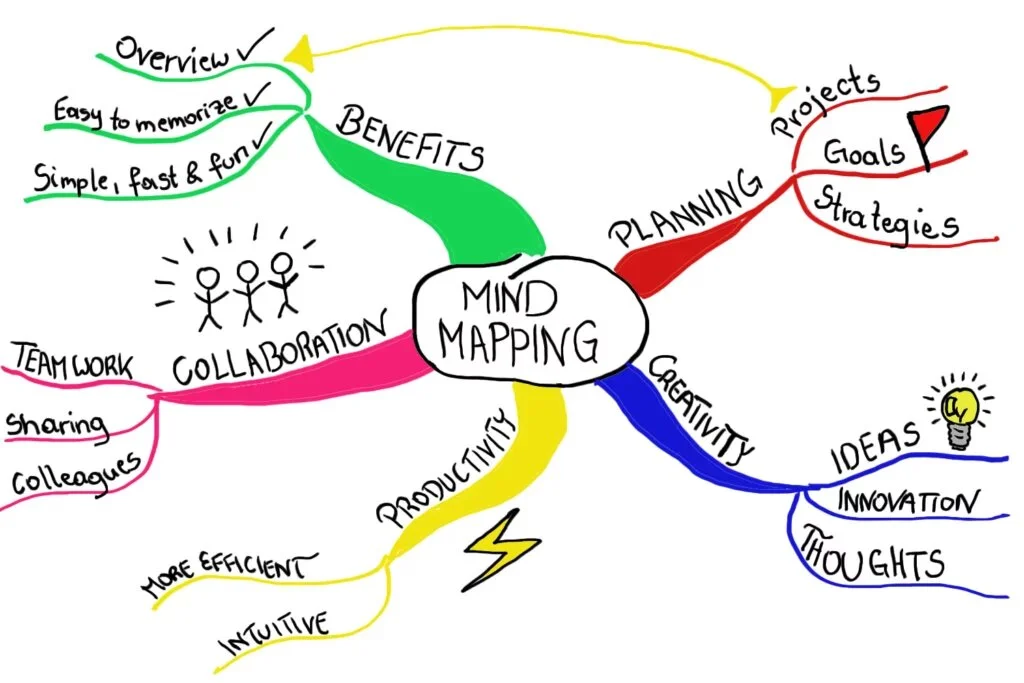Are you looking for a way to make your studying more interesting and effective? Do you want to connect what you’ve learned more easily? If your answers to these two questions are ‘YES’, try learning with mind maps and, believe me, you will be thrilled!
I have to admit that I resisted using mind maps (also know as mental maps) for my medical studies for a long time, and I didn’t even know why. When our professor at one lecture told us that we had to make a mind map for polycystic ovary syndrome, I had to research how to do it. When I made the map and looked at it, I was thrilled, and now I want you to be thrilled like me! Later in the text, I will show you what my colleague’s and my mind map for polycystic ovaries looks like!
What are mind maps?
Mind maps are a visual aid that allows for easier organization of information related to the main topic. You start by identifying the topic, which you will branch out into subheadings. We will take hypertension as an example, as the main topic. We can add the following branches – for cause, symptoms, complications, and treatment. Each of these branches can have its own smaller branches, on which you will write down all the facts you want. Mind maps allow you to create a hierarchy that shows the relationships and connections between information.
Example: My own mind map
By clicking on this subtitle, you can see the PDF version of my and my colleague’s mind map and check out how we did it.
As you can see, we branched out the topic into 4 parts – symptoms, diagnostic factors, risk factors, and therapy, to make it easier for us to present. We decided to only list the symptoms, but we explained each one during the presentation. For diagnostic factors, we wrote down US (ultrasound), and further branched it out according to what is seen on the ultrasound when PCOS (Polycystic Ovary Syndrome) is suspected – whether the ovaries are enlarged and whether there are stromal cysts. We also only listed the risk factors, to keep our map as clean as possible, but we branched out cardiovascular diseases. For therapy, we emphasized individuality, because there is no one therapy that suits everyone – there are many variations, but we gave an overview of what doctors advise for PCOS.
For the first mind map, it doesn’t look so bad, but now it looks much better when I make them. 🙂
The science behind mind maps
The effectiveness of creating mind maps is based on the research of Dr. Roger Sperry, a Nobel Prize winner, who is the creator of the concept of ‘cortical skills’. These are higher-level intellectual tasks performed by the right and left cerebral cortexes. Some of these tasks include processing logic, colors, lines, lists, numbers, and even imagination. Dr. Sperry’s research has shown that the more of these cortical skills we use when learning, the better the information is integrated. When we only use textbooks and notes, the brain is not as activated, but when we pictorially represent information and organize it, we increase the number of cortical skills we use.
What can we use mind maps for?
- Note-taking
- Brainstorming
- Problem solving
- Learning and memory
- Planning
- Research and consolidating information from multiple sources
- Presenting information
- Understanding complex ideas
- Expressing creativity
Mind maps can help you clarify anything, in many contexts – personal, family, educational or business. Planning your day or life, summarizing a book, working on a project, planning and creating presentations, writing blog posts – you can use mind maps for all of these!
How to create a mind map?
- Start: In the middle of a blank page, write or draw the idea you want to develop (I suggest you turn the paper horizontally).
- Elaboration: Draw several lines from the central concept/idea, which will lead to other sub-topics.
- Repetition: Repeat the same process for each subsequent subheading, connecting the corresponding sub-topics.
Bonus:
- Use colors, drawings and symbols: Don’t let the fact that you may not be an “artistic type” discourage you. Have fun! Your brain will thank you for using so many visual aids.
- Keep the titles of topics, sub-topics and subheadings short: You can use one word for everything or better yet, one image/drawing. While you’re still getting used to making mind maps, you’ll have a strong urge to write entire paragraphs, but always strive to shorten everything to one word or number – the map will then be more efficient!
- Vary the size of letters, colors and layout: Change the thickness and length of lines, all to emphasize important elements.
- Great TED talk about mind maps
- Another great TED talk
- If you want to make mind maps using software, watch this video.
Creating mind maps is an absolutely fascinating and rich topic, and I’ve only scratched the surface here. On the internet, you have a multitude of articles about them, as well as tutorials on how to create them. Please give it a chance – try this simple and yet very powerful tool and see for yourself its power. Have fun creating mind maps!
